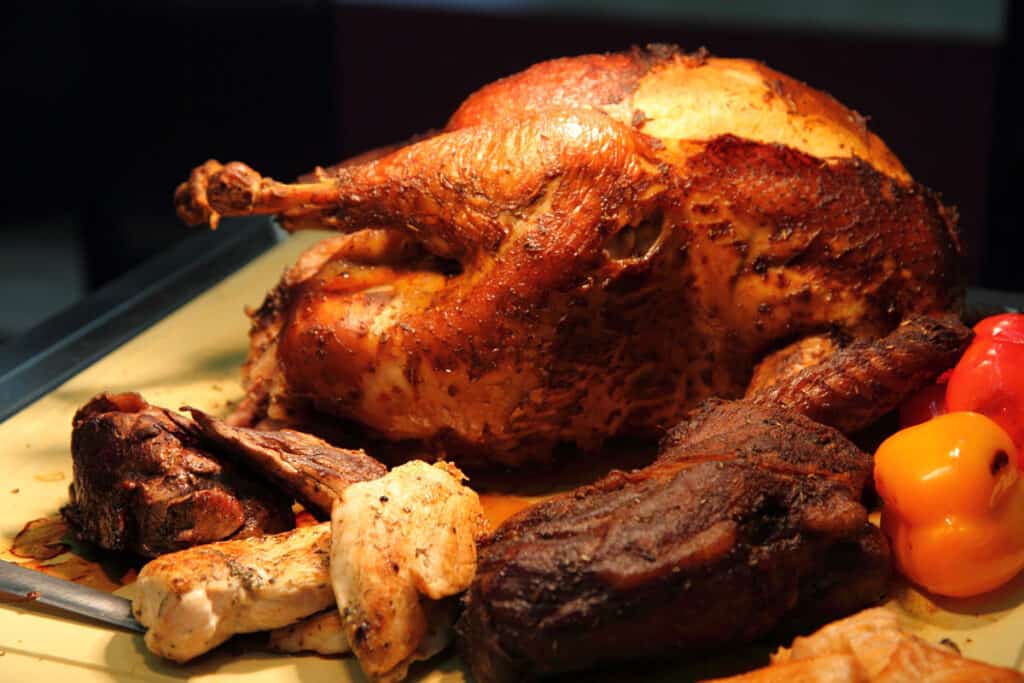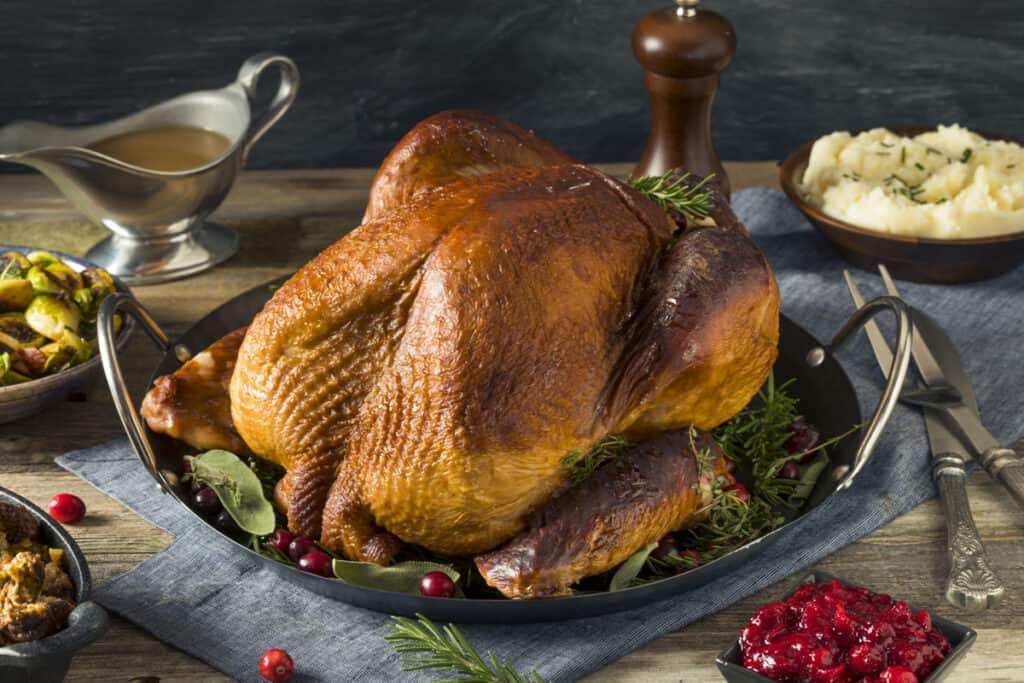Every pitmaster worth their salt knows about the danger zone—the temperature range at which bacteria can breed rapidly, thereby threatening the safety of your barbecue. But once the meat has cooked past the danger zone, how long will it be before it’s ready?
How Long To Get Turkey from 140 to 165
Once the turkey crosses the 140-degree threshold, it’s impossible to say for sure how long it will be before the meat is done. It could hit the target temp within 30 minutes, or it could take an hour or more. If it seems to be cooking too fast or too slowly, you can tent the breast portion with foil or adjust the cooking temperature.
What’s the Significance of the 140-Degree Mark?
You should always store meat at a temperature below 40 degrees, whether it’s raw or cooked. Cold temperatures slow the growth of bacteria, so the meat will keep longer in the fridge.
At 0 degrees and below, bacteria growth halts entirely. This is why you can store meat in the freezer indefinitely—at least in theory. Realistically, long stints in the freezer can cause the meat to dry out, so it’s best to thaw it as soon as possible.
When the meat’s internal temperature climbs above 40 degrees, the types of bacteria that cause food poisoning are able to breed at a rapid pace. Once it hits the 140-degree mark, though, the heat is able to fight back against the bacteria.
This is why the range between 40 and 140 degrees is called “the danger zone.” Keeping meat within this range for long periods can lead to illness, which is relevant to the topic we’re here to discuss.
How Long Can Meat Stay in the Danger Zone?
Whether meat is cooked or raw, you should never leave it out at room temperature for longer than 2 hours. When the weather outside is very hot—90 degrees or more—you’ll need to refrigerate the meat within 1 hour.
Once you’ve taken raw meat out of the refrigerator, it needs to cook to at least 140 degrees within 4 hours. Fortunately, that’s not usually an issue with whole turkeys, even when the specimen in question weighs 20 pounds or more.
Is Turkey Considered Done at 140 Degrees?
Since the turkey will be out of the danger zone at 140 degrees, does that mean it’s safe to consume at that temperature? Interestingly enough, the answer is no—although there has been some debate surrounding this topic.
The USDA recommends cooking poultry to an internal temperature of 165 degrees. That’s because the aforementioned bacteria can’t survive for longer than a couple of seconds at these temps.
Cooking the meat to 140 will keep the bacteria from multiplying, but at this temperature, they’ll take longer to die off. Therefore, it isn’t considered safe to eat poultry products that have achieved an internal temp of just 140 degrees.
Because the temperature of the meat will continue to rise as the turkey rests, we advise pulling the turkey from the heat when the breast meathas hit the 160-degree mark. That way, it will be thoroughly cooked, yet pleasantly juicy.
The drumsticks and thighs, on the other hand, should cook to 180 degrees before you take them off the heat. The dark meat can handle higher temps without drying out.
How Long To Get Turkey from 140 to 165 Degrees
So how long does it take to get turkey from the critical 140-degree point to the safe serving temperature of 165 degrees? Unfortunately, there’s no clear answer.
In truth, there’s no way to be certain exactly how long a turkey will take to cook, no matter what temperature range you’re looking at. The meat is safe to consume when it reaches 165 degrees, and not when the clock tells you it should be done.

You can make an estimatebased on the cooking temperature and the weight of the turkey. However, these are just guidelines. The only way to make sure the turkey has finished cooking is to test the internal temperature with a meat thermometer.
How Long For Turkey To Go from 150 to 165?
Does turkey stall? This is one of the most common questions we get from people who are new to smoking whole turkeys.
The stall—the point at which a large cut of meat seems to stop cooking for hours on end—usually occurs at around 150 degrees, and is common when smoking brisket and pork butt. Can turkey be afflicted by this phenomenon as well?
Since the stall is caused by evaporative cooling, in theory, it can affect any cut of meat. But since the turkey cavity is hollow and therefore less dense than a solid cut like brisket, the stall period isn’t likely to last long—if it happens at all.
If you notice that the thermometer seems to be holding at 150 degrees or so, be patient. The number should begin to rise again in 30 to 60 minutes. If it doesn’t, try testing the temperature in a different spot.
What if the Turkey is Cooking Too Fast?
Let’s say you’ve tested the internal temperature at the estimated halfway point, and the breast meat has already cooked to 140 degrees. There’s no need to panic—in fact, it’s a good sign that the turkey has pulled out of the danger zone at this point.
If you’re worried that the turkey is cooking too fast, you have a couple of options. One might be to tent the turkey breast with foil to shield it from the heat. While this can slow things down, it may also result in rubbery skin.
You can also lower the temperature of the oven or smoker by 10 to 25 degrees. There’s a chance that the unit is running hotter than the set temp. If you suspect that this is the case, it’s a good idea to get the unit serviced before you attempt to use it again.
If all else fails and the turkey is readybefore you are, you can keep it warmin a low oven until serving time. Alternatively, wrap the turkey in foil and place it in a preheated cooler. The meat should stay above 140 degrees for up to 4 hours.
Factors That May Affect The Cooking Time
The total cooking time can fluctuate based on a number of circumstances. Here’s a list of the most common ones.
- Cooking method (roasting vs. smoking)
- Accuracy of the oven or smoker (the temperature may fluctuate by up to 50 degrees)
- Positioning of the turkey on the cooking grate
- Whether or not you use a roasting pan, and the depth and size of the pan
- Accuracy of theturkey’s listed weight
- Exact dimensions of the turkey
- Fat content of the turkey
- Temperature of the turkey when it went into the oven or smoker
- Whether you tented the bird with foil at any point during the cook
- Whether the meat was fully thawedor still frozen in the cavity
- Whether you opted to stuff the turkeyor fill the cavity with other ingredients
In short, your estimate should help you decide when to start cooking the turkey in the hope that it will be done by the time you plan to serve dinner. But only the turkey can tell you when it’s finished cooking.

Make sure to calibrate your meat thermometer on a regular basis, too. If the probe gives you an inaccurate readout, you may wind up with over- or undercooked turkey despite your best efforts.
Tips on Thawing Turkey
By ensuring that the turkey is completely thawed, you can make a more accurate guess regarding the length of the cook.
Turkeys that are still partially frozen can take 25 percent longer to cook than specimens that were fully defrosted. If you were to cook a turkey that was still frozen solid when you put it in the oven or smoker, it could take 50 percent longer to hit the right temp.
Although it’s safe to cook a turkey from a frozen state, doing so will cause the meat to cook unevenly. By the time the frozen sections in the middle have reached a safe temperature, the outer layers will be overcooked and dry.
For best results, take the turkey out of the freezer a few days before you plan to cook it. You should allow 24 hours for every 5 pounds of meat, so a 15-pounder should be defrosted in 3 full days.
Set the turkey breast side up on a rimmed baking sheet or platter. This step is important because it will prevent the turkey’s juices from spilling all over the fridge as the meat thaws.
Place the turkey on the lower shelf of the fridge. Check to make sure your refrigerator temperature is set to 39 degrees or lower, then close the door. If you’ve given yourself sufficient time, the bird should be thawed on the day you’re ready to start cooking.
The Bottom Line
There’s no telling how long you’ll have to wait between the 140- and 165-degree markers. However, there are steps you can take to ensure that the turkey will be perfectly cooked by the time you’re ready to start carving.
Best of luck, and happy grilling!

